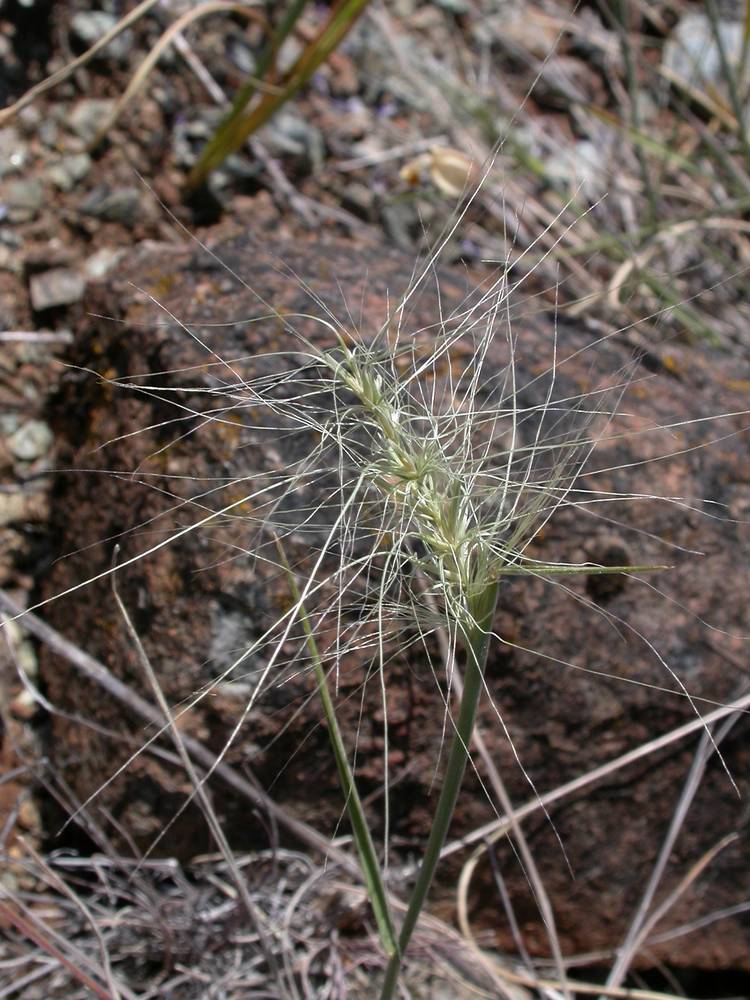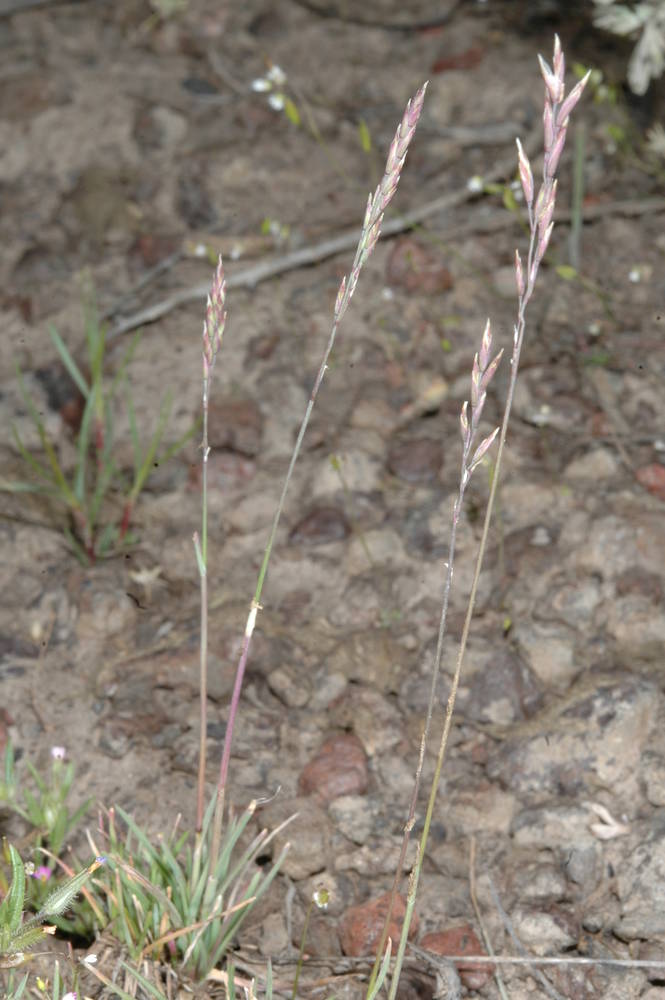Elymus multisetus
Poaceae
big squirreltail
grass family
erect to ascending.
usually herbaceous; erect to sprawling;
internodes hollow or solid;
nodes prominent and usually swollen.
sheaths glabrous or white-villous;
blades 1.5–4 mm wide;
upper surfaces scabrous or hairy.
alternate, 2-ranked; each consisting of a sheath that encircles the culm and a blade;
sheaths open or closed with margins fused for much or all of their lengths;
auricles present or absent;
ligules usually present at the sheath-blade junction; on the side toward the culm, membranous or of hairs, rarely absent;
blades usually linear to lanceolate with parallel veins.
5–20 cm; erect, sometimes partially enclosed in the sheath of the uppermost leaf, 2 spikelets per node or rarely 3–4 at some nodes;
internodes 3–5(8)mm;
disarticulation initially at the rachis nodes; later beneath each floret.
usually complex aggregations of spikelets into panicles; racemes, or spikes, usually with a main axis;
spikelets usually supported on pedicels;
disarticulation above or below the glumes, usually beneath each floret, sometimes in or below the inflorescence axis.
10–15 mm, divergent, 2–4 florets; lowest florets sterile and glume-like in 1 or both spikelets at each node.
consisting of 2 glumes subtending 1–many florets arranged on either side of the rachilla, laterally or dorsiventrally compressed, occasionally round in cross section.
(10)30–100 mm including the awns; the bases hard and glabrous;
glume bodies about (2)5–10 × 1–2 mm, setaceous, 2–3-veined;
margins firm;
glume awns (8)25–90 mm; each split above the base into 3–9 unequal divisions, scabrous, flexuous to outcurving from near the bases at maturity.
(0)2, with an odd number of veins, sometimes awned.
(0)3(6).
usually bisexual, sometimes pistillate, staminate or sterile, usually consisting of a lemma and palea with the flower between them; the flower itself reduced to stamens; a pistil; and 2 lodicules.
usually a caryopsis.
fertile lemmas 8–10 mm; smooth or scabrous near the tips, 2 lateral veins extending into bristles to 10 mm;
lemma awns (10)20– 110 × 0.2 mm at the base, divergent to arching.
usually with an odd number of veins, awned or awnless, with calluses;
lemma awns; if present, arising at the tip; along the back or near the base, sometimes curved; bent, or twisted.
1–2 mm.
usually 2-keeled, often with additional veins.
=28.
Elymus multisetus
Poaceae
Dry, often rocky grasslands and savannas. 50–2000m. BR, Col, ECas, Lava, Sisk, WV. CA, ID, NV, WA; southeast to CO, south to Mexico. Native.
Elymus multisetus has inflorescences that fall apart at maturity and glumes that are divided into three to nine widely spreading awns. Very similar E. elymoides has glumes that are entire or unevenly split into two to three parts. Determining how much the glumes are split is complicated by the presence of glumelike sterile lemmas in both E. multisetus and some E. elymoides subspecies. Elymus multisetus glumes are divided above the base. If the glumes appear to be divided to the base, the plant is more likely to be E. elymoides.
Cosmopolitan. Approximately 700 genera; 99 genera treated in Flora.
With approximately 11,000 species, Poaceae is the fourth largest plant family in the world and the most economically and ecologically important. Grasses grow in most terrestrial habitats and are dominant or co-dominant in grasslands and savannas. The world’s major grain crops are grasses, including corn, rice, wheat, barley, sorghum, millet, oats, and rye. Some grass species are serious weeds, threatening natural ecosystems, harming livestock, and competing with cultivated crops. Arundo donax, giant reed, has spread very locally from ornamental plantings in Jackson County. Plants are strongly rhizomatous; culms (2)3–10m tall, 2+cm wide near the base; leaves 30–100 × 2–7(9)cm; inflorescence a fluffy panicle; lemmas 8–12 mm with hairs 4–9 mm. Efforts are being made to eradicate this population. It is an invasive weed in California. The following identification hints may be helpful when keying within this family: If the inflorescence is a dense spike, break the inflorescence axis to isolate a node and count the spikelets attached there. Spikelet and lemma measurements exclude the awns. To determine spikelet compression, break off a single spikelet and lay it down. If both glumes are visible at the same time, it is laterally compressed. If only one glume is visible, it is dorsiventrally compressed.
Barbara Wilson, Richard Brainerd, Nick Otting
- Local floras:
CA,
OR,
WA
- Local Web sites:
CalFlora,
CalPhotos,
Flora NW,
PNW Herbaria
WildflowerSearch
iNaturalist (observations)
USDA Plants Database
- LBJ Wildflower Center
- SEINet
- Plants of the World Online
- Encyclopedia of Life
- Wikipedia
- Google Image Search
- Local floras:
OR
- Local Web sites:
Flora NW,
PNW Herbaria
WildflowerSearch
iNaturalist (observations)
- LBJ Wildflower Center
- SEINet
- Plants of the World Online
- Encyclopedia of Life
- Wikipedia
- Google Image Search




